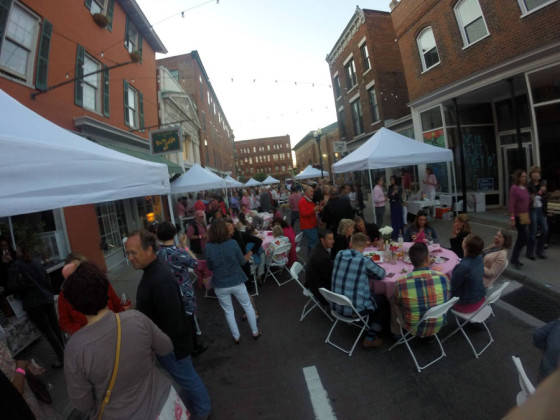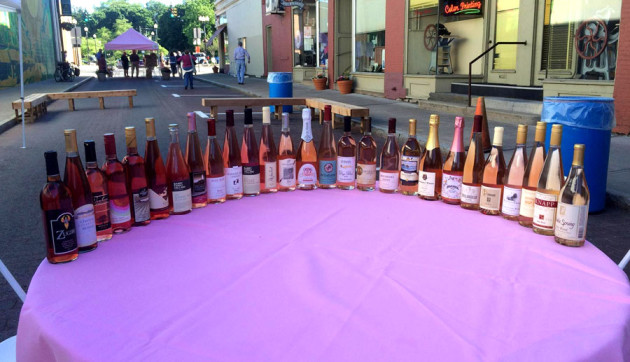Photo via David Diaz, Damiani Wine Cellars
No one is immune to bad ideas, and for years, the Finger Lakes had consistently bad ideas when it came to rose. It all seemed to culminate in one ill-fated February evening in 2014. You might be wondering why anyone was talking about rose in February, and you would be on to something.
On the evening Thursday, February 27th, 2014, Fox Run Vineyards hosted an industry and media “Discover Dry Rose Grand Tasting.” Perhaps you recall that January and February of 2014 had been colder than an ex-lover, hammered by snow and raw wind. It was steak-and-red-wine weather. Nonetheless, the media was asked to think about rose when what we really wanted was Northern Rhone.
That afternoon, the first of six inches of snow came quickly. Rochester roads were snarled. I gave up before I reached the thruway, headed home, and opened a bottle of Saint-Joseph.
Happily, that event appears to have marked the end of the ‘Bad Ideas in Rose’ era in the Finger Lakes. The region is a collective rose powerhouse, which is no small change. How did we get here? How is it that when you throw a dart at a wall of Finger Lakes rose, you’re more likely going to hit something really good?
One of the first winemakers to make an outstanding local rose has some ideas. Morten Hallgren’s first rose was released by Ravines Wine Cellars after the 2003 vintage. He noticed that rose was, for many of his colleagues at the time, an afterthought.
He did not approach it that way.
“It started as a dedicated rose program,” Hallgren said. “There was this misconception that you can just make rose from grapes that were not ripe enough to make red wine, which is totally false. It will show up just as poorly as it would in a red.”
One of the region’s newest — and strongest — rose producers is Kelby Russell, winemaker at Red Newt Cellars and owner of his own eponymous label. Can rose be an afterthought? On the contrary, Russell feels it might be the most exacting wine he makes.
“We work closely on the sourcing of the fruit, working with the Anthony Road team on Nutt Road, taking it perhaps more seriously than we would even take a red wine,” Russell said. “Because with dry rose, you have no oak, you have no aging in bottle or in barrel. It’s really a high-wire act to get that wine into bottle as fast as you have to, and hit the market ready to go.
“It comes down to preserving acidity and having a crisp finish in the wine,” Russell explained. “I think that’s really the key in dry rose: emphasizing the dry point, especially when so many people see pink and think there is a sweetness to it.”
And here’s where Russell astutely observes the region’s evolution with rose: they’ve essentially been down this road before. “We’re well versed, in the Finger Lakes, having to convince people that riesling doesn’t always have to be sweet. So transitioning them to rose is really a natural pivot point for us.”

Hallgren points out that most retail wine shops now offer a dedicated rose selection during the warmer months. The Finger Lakes slice of that section is growing. And after that snowbound February mess in 2014, the region has gone the other way. The best event of the year might be the Rose Soiree in June in Geneva. Hosted by Microclimate Wine Bar on the absurdly charming Linden Street, the soiree drew 300 people in 2014 and topped that number in the 2015 version.
This is not likely a trendy wine moment, like pet nat or orange wine. Rose makes sense. It need not be complex; it is the companion on — or the antidote for — an 85-degree day. There are so many well-made Finger Lakes roses that it would be silly to start listing them, but I’ll mention two. It’s a thrill to see rose in magnum, from Forge Cellars, and my favorite this season (so far) has been from Sheldrake.
“Perhaps short of steak, there’s not much it can’t go with, and even a cold steak salad is a nice match,” said Russell, defending rose as not simply a seasonal wine. Hallgren bends a bit more on that issue.
“Yes, there’s a seasonal aspect to it, but the season seems to be getting longer and longer,” he said.
It’s remarkable what good viticulture can do. So I’ll close with an admission of my own bad idea. I talk to winemakers plenty; I talk to vineyard managers not nearly enough. They’re a significant reason that Finger Lakes rose is so consistently good. I don’t know if I’ll be drinking rose in February, but right now it’s July, and I couldn’t be happier to find so much Finger Lakes rose in my local wine shop.

